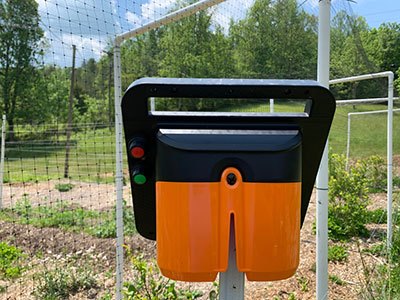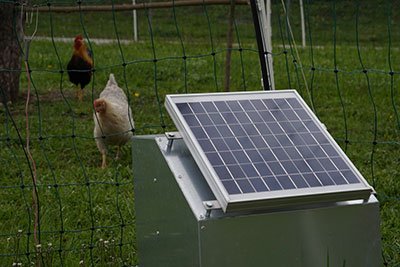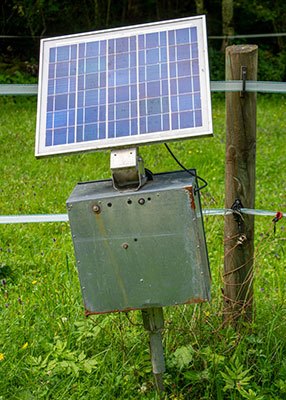Is safeguarding your property from trespassers on your priority list? Solar electric fencing is the way to go if you want to keep unwanted guests away! This specially designed fencing system uses solar power which ensures that it keeps running around the clock, given enough daylight of course.
But how do you install a solar electric fence? Don’t worry, we have all the answers for this as well as many additional tips and tricks so that your installation process can be smooth and effective.
Take away key points:
- Installing a solar fence is not difficult, but you must follow the procedure thoroughly, and prepare the tools in advance
- Always install your fences in the sun to ensure maximum power and energy, for charging your fence with the power of the sun
- Check the fence chargers regularly, and prevent their damage for required electric energy and impulse
Table of Contents
- Solar fence installation: A full procedure
- Pre-step: Gathering necessary tools
- Step 1: Determine the fence location
- Step 2: Choosing the right solar panel
- Step 3: Installing fence posts
- Step 4: Attaching solar panel to the fence
- Step 5: Connecting fence to the battery & solar fence charger
- Step 6: Test the fence to ensure it’s working properly
- Step 7: Rest assured your animals are safe and sound inside the fenced property
- Benefits of solar fences
- FAQs
- Summary
If you want to learn more about solar-powered electric fences and installation, preparation steps, and procedures, read our guide below. You will find a full step-by-step procedure for your fence lines.
Solar fence installation: A full procedure
To install solar-powered electric fences in a cost-effective, environmentally-friendly way, follow the steps below.
Pre-step: Gathering necessary tools

To install a solar-powered electric fence, you will need the following:
– Solar fence charger
– Solar panels
– Solar battery
Solar chargers are equipped with solar panels that absorb sunlight and convert it into energy to power the solar electric fence line.
Post-insulators and electric fence wire are necessary to construct the physical electric fence line. Ground rods will need to be installed to provide a ground for the solar-powered electric fence.
Additionally, a solar battery will be required to store the energy generated by the panel for use during periods of low sunlight and optimal work of your electric fencing.
Step 1: Determine the fence location
To begin the installation of a solar-powered electric fence line, the initial step is to determine the location of your solar fencing. You must choose a well-lit area where the sun is abundant as the panel solar charges the battery.
Also, it is essential to place the solar electric fencing in an area where animals are unlikely to wander off or become caught in it when installing the construction.
Step 2: Choosing the right solar panel
When selecting a solar panel for your solar-powered electric fence, the subsequent step is to pick the appropriate type. The three main types of solar cells are: monocrystalline, polycrystalline, thin-film solar panels.
Monocrystalline panels are produced from one big silicon crystal and are the most effective but also the most costly panel type for fence chargers.
Polycrystalline panels are composed of multiple smaller silicon crystals and are less effective than monocrystalline panels, but they are also less expensive, working well with the solar energizer.
Thin-film panels consist of a thin layer of semiconductor material and are the least efficient variety of panels, but they are also the least expensive and probably work with solar chargers.
Step 3: Installing fence posts
At your nearby hardware store, you can purchase fencing posts. It’s important to get posts composed of rust-resistant materials such as aluminum or stainless steel.
Once the fencing posts are obtained, the following step is to put them in place. The initial step is to excavate a hole with a post-hole digger for each post that is roughly two feet deep.
When the holes are ready, put the first post in and then fill the holes with concrete. The concrete will aid in securing the posts in place and protecting them from being knocked over by animals. So, once you install a solar fence, it will not become unstable and you can check every corner for extra support.
Step 4: Attaching solar panel to the fence
To proceed, you must fasten the solar panel to the fence using brackets. The panel should be secured to the posts in a way that is well-oriented to get sufficient sun.
Step 5: Connecting fence to the battery & solar fence charger

To proceed, connect the fence to the battery and solar charger. Use wires to link the positive and negative terminals of the battery to the fence solar charger.
Also, connect the grounding wire, insulated wire, and ground rod system properly, to ensure there won’t be issues with electricity and signal problems with the electrical current. Don’t forget connector clamps and the grounding clamp for electric energy and maximum power. When completed, the solar-powered electric fence will be ready for use.
Step 6: Test the fence to ensure it’s working properly
To verify that the solar-powered electric fence is functioning properly after installation, follow these steps:
– Ensure that the fence is powered on and the batteries are fully charged with the electric charger.
– Wear gloves and touch the fence wire in various places and ground rods to verify proper current flow, power, and energy to keep your fencing optimal.
– Keep an eye out for any indications of a malfunction, such as wire gaps or loose connections. Repair any issues before using the fence.
– Keep the weed growth optimal, and keep every corner of your fence clean, to ensure maximum power of the electric fence charger and wires.
– Use the fence tester to ensure there is adequate voltage power necessary to keep your animals safe.
– Check the solar chargers and see if there is a mistake with the fence charger. If there is you must replace the solar charger, as it won’t provide the necessary electric levels to keep your fence terminal optimal.
Step 7: Rest assured your animals are safe and sound inside the fenced property
Having a sense of calm and well-being is priceless. Knowing that your livestock or animals are secure and safe can provide that.
Therefore, a significant number of people prefer to install solar-powered electric fences to ensure their animals’ safety from harm. Opting for a solar-powered electric fence is an excellent approach for keeping your animals protected and putting your mind at ease.
Benefits of solar fences
Here are some of the main benefits the solar fencing systems offer:
– Completely self-sufficient
– Environmentally-friendly since they don’t depend on fossil fuels
– Low maintenance since they lack moving parts that can break
– Durable and can withstand harsh weather when installing and using them
– Easy to install and connect to the ground terminal and solar energizer
FAQs
Can I install an electric fence myself?
Yes, you can install the fence on your own, but you need to prepare all the materials in advance and find the best location to install a solar fence.
Does an electric fence have to make a complete loop?
No, for a solar fence to be installed properly, you don’t need a closed loop.
What are the disadvantages of a solar electric fence?

Disadvantages include:
– Solar fences are more expensive than regular fencing systems
– The investment is higher, but they can save money in the long run
– They can operate optimally only in sunny areas, so they are not the best solution for cloudy and shady locations
Do fence panels need a gravel board?
No, these are not essential parts of the fence materials.
What size solar panel for electric fence?
To calculate the size of the solar panel needed for your electric fence, the general rule is to have ten watts of a solar panel for each output joule of your fence energizer. For instance, if your energizer has three joules, then you’ll need a 30-watt solar panel.
Do electric fences work in the rain?
Yes, electric fences work well even in rainy conditions.
Summary
Solar-powered electric fences can ease the job of keeping pests out of your garden. The key is to get the right tools and ensure that you set up the right position. The installation process can be done in a few easy steps which will give you peace of mind while protecting your plants from predators.
Moreover, it is an eco-friendly decision since these solar chargers are powered by the sun, so you’ll never have to worry about high electricity bills ever again.
Altogether, solar-powered electric fences provide a great way to secure fencing around your garden and invoke numerous benefits making it worth considering for such a purpose.
